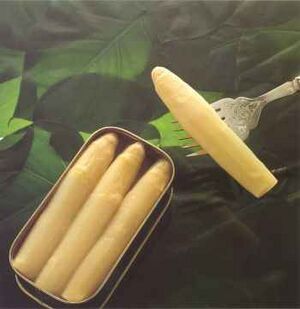Asparagus

Only the young shoots of asparagus are eaten. Asparagus is low in calories, contains no fat or cholesterol, and is very low in sodium. It is a good source of folic acid, potassium, dietary fibre, and rutin. The amino acid asparagine gets its name from asparagus, the asparagus plant being rich in this compound.
The shoots are prepared and served in a number of ways around the world. In Asian-style cooking, asparagus is often stir-fried. Cantonese restaurants in the United States often serve asparagus stir-fried with chicken, shrimp, or beef, also wrapped in bacon. Asparagus may also be quickly grilled over charcoal or hardwood embers. It is also used as an ingredient in some stews and soups. In the French style, it is often boiled or steamed and served with hollandaise sauce, melted butter or olive oil, Parmesan cheese or mayonnaise. The best asparagus tends to be early growth (meaning first of the season) and is often simply steamed and served along with melted butter. Tall asparagus cooking pots allow the shoots to be steamed gently.
Asparagus can also be pickled and stored for several years. Some brands may label them as "marinated" which means the same thing.
Asparagus grown for consumption needs to be checked daily as the shoots very quickly become inedible and grassy.
Chef's tip
To cook asparagus evenly, especially tougher, large out-of-season asparagus, using a speed peeler, shave the skin from around the stump-end so the spear is an even circumference along the whole length. Rub with a little olive oil and salt and griddle until lightly charred. They are also nice, grilled and served with a little beurre noisette.
Marchfeldspargel

Marchfeldspargel is an Austrian asparagus with g.g.A. protection. The asparagus stalks are the shoots of cultivated varieties developed from the asparagus plant {Asparagus officinalis L.) for supply in their fresh state. They are divided into four categories according to their colour: white, violet, violet-green or green asparagus.
The name Marchfeld describes the fertile plain east of Vienna between the rivers Danube and March. It is demarcated by the Danube to the south, the March to the east, the Weinviertel hills to the north and the Vienna city boundary to the west. The Marchfeld region is in the western foothills of the Pannonian Steppes. The climatic conditions there coupled the particular soil types - riverside, chernozem, colluvial and alluvial soils with high humus levels and varying high levels of loam and loess form the perfect combination for asparagus growing.
The Marchfeld has been an important name in asparagus cultivation since the 19th century - a number of holdings were suppliers to the imperial court. The Bund der Marchfelder Spargelgüter [growers' association] has existed since 1980. Marchfeld asparagus has been marketed with a common label since then.
Only selected varieties are cultivated because of the special climate and soil conditions. Carefully picked by hand, immediately chilled and accurately graded, the asparagus is marketed throughout Austria within 24 hours.
Reference: The European Commission

Espárrago de Navarra is a tender, fresh shoot of Asparragus officinalis L, purplish, white or green, of the varieties ‘Argenteuil’, ‘Dariana’, ‘Desto’, ‘Cipres’, ‘Grolim’, ‘Juno’, ‘Steline’ and ‘Thielim’, for consumption when fresh or preserved, of set length, diameter and class.
It must be grown in the central Ebro valley, the production area covers 263 municipalities in Navarre, Rioja and Aragon in clay or open clay soils with slightly basic pH; the climate is continental with a Mediterranean influence and the mean temperatures are 13 to 14C. The producers have to use appropriate cultivation, harvesting and production techniques, which are inspected.
Reference: The European Commission
- See also Espárrago de Huétor-Tájar.
How much does one cup of asparagus weigh?
Estimated US cup to weight equivalents:
| Ingredient | US Cups | Grams | Ounces | |
| Asparagus | fresh/raw - cut in pieces | 1 |
125 grams | < 5 ounces |
| Asparagus | tinned/cooked - cut in pieces | 1 |
175 grams | 6 ounces |
Conversion notes:
Every ingredient has a cups to ounces or grams conversion table. Search for the ingredient, cup to weight conversions are at the end of each ingredient page.
We also have a generic conversion table and a portions per person lookup.
Seasonal Information: Asparagus
This information is specifically for countries in the northern temperate zone of the Northern Hemisphere; particularly the United Kingdom, however it should be applicable for northern USA, northern Europe, Canada, Russia, etc.
Asparagus is at its best and in season during the following months: April, May & June.